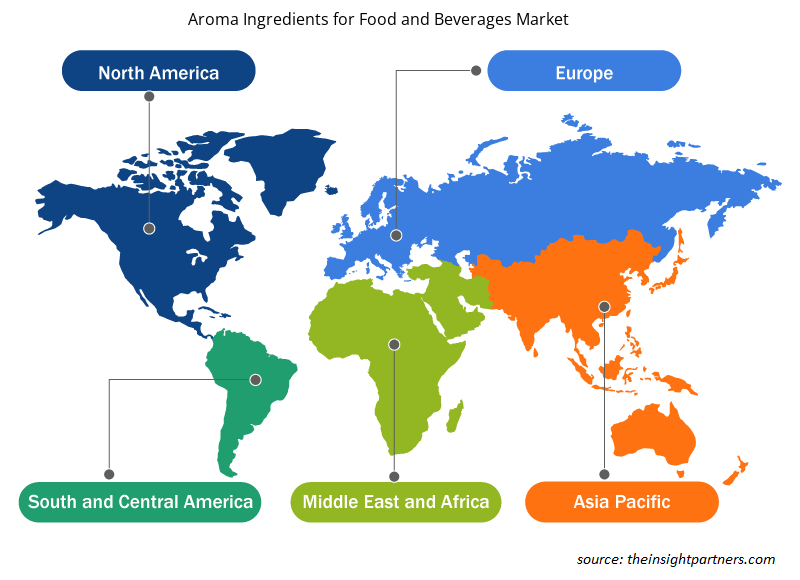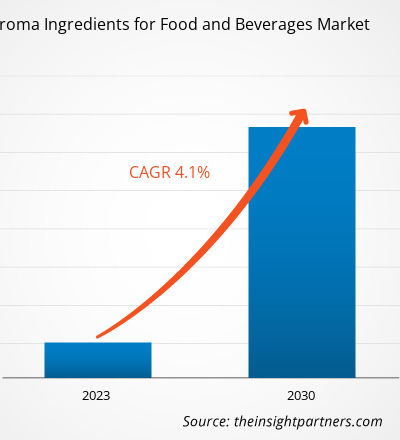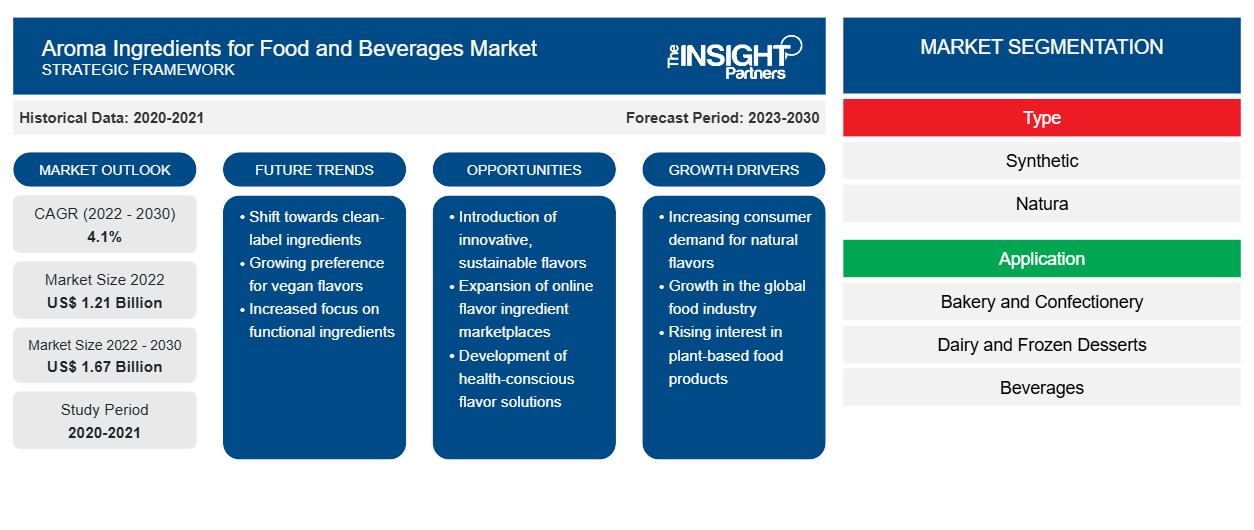[調査レポート] 食品・飲料向け香料原料の市場規模は、2022年の12億1,000万米ドルから2030年には16億7,000万米ドルに成長すると予測されており、市場は2022年から2030年にかけて4.1%のCAGRを記録すると予測されています。
市場洞察とアナリストの見解:
芳香成分は、天然由来の成分から分離されるか、石油から化学的に抽出されます。これらの成分は、菓子や風味のあるスナックからアルコール飲料やノンアルコール飲料まで、さまざまな食品や飲料の風味と香りのプロファイルを形成する上で重要な役割を果たします。食品および飲料業界における芳香成分の重要性の高まりと、主要な市場プレーヤーによる戦略的取り組みは、食品および飲料市場向けの芳香成分を推進する主な要因です。さらに、ユニークでエキゾチックな風味と香りの体験に対する消費者の需要の高まり、および抽出および合成技術の進歩は、市場環境の形成にさらに役立ちます。ただし、食品および飲料業界での芳香成分の使用に関連する規制上の制約は、食品および飲料向けの芳香成分市場の成長を妨げています。
成長の原動力と課題:
食品・飲料業界の香料原料メーカーは、消費者を引き付け、市場での地位を強化するために、合併や買収、コラボレーション、その他の戦略的開発に大きく関与しています。パンや菓子、乳製品、冷凍デザートなどを製造・販売するさまざまな食品・飲料施設からの香料原料の需要が高まっているため、主要企業は世界的に市場での地位を強化するために戦略的イニシアチブを採用しています。たとえば、2023年11月、BASF SEは、Isobionics Natural alpha-Bisabolene 98とIsobionics Natural (-)-alpha-Bisabolol 99という2つの新しい天然香料原料の発売を発表しました。このような製品開発は、食品および飲料市場向けの香料原料を牽引しています。
市場の主要企業は、生産施設を拡張し、販売業者と契約を結んで市場での地位を強化しています。たとえば、2021年12月、Tilley Distribution、Inc.はPhoenix Aromas and Essential Oilsとの合併を発表しました。この合併により、規制および技術サポートの提供に経験豊富なチームとともに、新規および既存の消費者ベースに高品質の製品を提供できるようになります。さらに、2021年7月、Symrise AGは、B2B顧客向けにカスタマイズされたソース、ディップ、ドレッシング、シロップ、飲料濃縮物を製造するカナダの生産者であるカナダに拠点を置くGiraffe Foods Inc.を買収しました。この買収により、Symriseの北米でのFlavor&Nutritionセグメントが拡大し、市場での地位と顧客ベースが向上します。このように、主要な市場プレーヤーによる戦略的イニシアチブは、食品および飲料市場の成長を世界的に促進しています。
さまざまな食品や飲料の用途における芳香成分の製造と使用は、さまざまな政府機関によって規制されています。食品医薬品局 (FDA) や欧州食品安全機関 (EFSA) などの規制機関は、消費者の安全と製品の品質を確保するために、芳香成分の使用に関する厳格なガイドラインと基準を課しています。たとえば、国連環境計画は食品アロマの使用を規制しています。この規制は、食品における香料や芳香成分またはアロマを正しく、管理された状態で、安全に使用するために必要なすべての条件を規定しています。さらに、食品医薬品局 (FDA) は、食品内および食品上で使用できる食品アロマに関する規制を課しました。これらの規制要件を満たすには、広範なテストと文書化のプロセスが必要であり、メーカーにとって時間とコストがかかる可能性があります。芳香成分の承認プロセスは長くて複雑になる可能性があり、業界内でのイノベーションと製品開発をさらに妨げています。
要件に合わせてレポートをカスタマイズする
このレポートの一部、国レベルの分析、Excelデータパックなど、あらゆるレポートを無料でカスタマイズできます。また、スタートアップや大学向けのお得なオファーや割引もご利用いただけます。
-
このレポートの主要な市場動向を入手してください。この無料サンプルには、市場動向から見積もりや予測に至るまでのデータ分析が含まれます。
レポートのセグメンテーションと範囲:
「2030 年までの世界の食品および飲料向け香料原料市場分析」は、市場動向と成長機会に重点を置いた専門的で詳細な調査です。このレポートは、タイプとアプリケーションによる詳細な市場区分とともに市場の概要を提供することを目的としています。市場は最近高い成長を遂げており、予測期間中もこの傾向が続くと予想されます。このレポートは、世界の食品および飲料向け香料原料の消費に関する主要な統計を提供します。さらに、世界の食品および飲料向け香料原料市場レポートは、世界の市場パフォーマンスに影響を与えるさまざまな要因の定性的な評価を提供します。このレポートには、市場の主要プレーヤーとその主要な戦略的展開に関する包括的な分析も含まれています。主要な推進要因、市場動向、および収益性の高い機会を特定するために役立つ、市場ダイナミクスに関するいくつかの分析も含まれています。
食品および飲料市場の予測における芳香成分は、主要な企業の出版物、協会データ、データベースなど、さまざまな二次および一次研究結果に基づいて推定されます。さらに、エコシステム分析とポーターの 5 つの力の分析により、市場の 360 度のビューが提供され、サプライ チェーン全体と市場のパフォーマンスに影響を与えるさまざまな要因を理解するのに役立ちます。
セグメント分析:
食品・飲料市場向けの香料原料は、種類と用途に基づいて分類されています。タイプ別に、市場は合成と天然に分かれています。合成セグメントはさらにテルペン、アルデヒド、脂肪族、その他に分類されます。天然セグメントはさらにエッセンシャルオイル、ハーブエキス、オレオレジン、その他に分かれています。2022年には、合成セグメントが食品・飲料市場シェアで最大のアロマ成分を占めました。天然セグメントは、2022年から2030年にかけて最高のCAGRを記録すると予想されています。合成アロマ成分は、食品や飲料に含まれる天然フレーバーを模倣した化合物です。食品・飲料業界でこれらの成分の需要が急増している理由はいくつかあります。まず、合成アロマ成分はフレーバープロファイルに一貫性を持たせ、天然成分のばらつきに関係なく、製品の味が毎回同じになるようにします。この一貫性は、ブランドアイデンティティと消費者満足度にとって非常に重要です。第二に、天然アロマ成分に比べてコスト効率に優れているため、特に大規模生産において、メーカーにとってより入手しやすいものとなっています。さらに、フレーバー科学の進歩により、天然フレーバーを忠実に再現する合成原料が開発され、消費者の馴染みのある味に対する好みを満たしながら、ユニークなフレーバーの組み合わせを提供しています。結論として、天然原料の安定性と入手可能性に関する懸念と規制圧力により、食品・飲料業界では合成香料原料の採用がさらに促進されています。
地域分析:
市場範囲は、北米、ヨーロッパ、アジア太平洋、中東およびアフリカ、南米および中米の5つの主要地域に焦点を当てています。アジア太平洋地域は、2022年に食品および飲料の香料原料市場で最大のシェアを占め、市場価値は約4億2,500万米ドルでした。ヨーロッパが2番目に大きなシェアを占め、次いで北米が続きました。
ヨーロッパでは、芳香成分の需要が高まっているのは、この地域の豊かな料理の伝統と、高級品や職人技による製品への嗜好の高まりによるものです。ヨーロッパ全域で、料理の伝統と料理に対する文化的評価が高まっています。ヨーロッパの消費者は高品質の成分と本物の味を重視しており、それが感覚体験を高める芳香成分の需要を促進しています。このグルメの卓越性への重点により、自然で持続可能な供給源から調達された高級芳香成分の市場が拡大し、ヨーロッパの消費者の目の肥えた味覚に応えています。さらに、ヨーロッパではより健康的でより自然な食品の選択肢への関心が高まっており、市場の成長に貢献しています。ヨーロッパの消費者はオーガニックや植物ベースの食事を受け入れており、特定の野菜、穀物、豆類など、強い味や馴染みのない味や香りの成分を取り入れることがよくあります。これらの健康志向の選択をより魅力的にするために、食品メーカーは芳香成分を使用して強烈または不快な味や香りを和らげ、製品が自然でクリーンなラベルのトレンドに従いながら、幅広い消費者に受け入れられるようにしています。この需要は、ヨーロッパ全体の食品の品質、味、感覚体験に対する意識と一致しており、この地域での食品や飲料への芳香成分の採用に貢献しています。
北米では、食品および飲料市場向けの芳香成分は、コンビニエンスフードやパッケージ食品の売上増加、確立された食品産業、機能性飲料に対する消費者の嗜好の高まりに起因しています。芳香成分はこれらの製品において、製品全体の香りを高め、消費者にとってより魅力的なものにする上で重要な役割を果たしています。天然およびクリーンラベル製品に対する消費者の嗜好の高まりも、市場の成長にさらに貢献しています。健康とウェルネスに対する意識が高まり続ける中、消費者は天然の芳香成分を含む製品を求めるようになっています。そのため、食品および飲料メーカーは、消費者の需要を満たすために、果物、ハーブ、スパイスなどの天然源から抽出した芳香成分を取り入れるようになりました。さらに、食品および飲料セクターにおけるプレミアム化に向かう食品および飲料向け芳香成分市場の傾向も、需要の増加に貢献しています。
食品・飲料向け香料原料市場の地域別分析
予測期間を通じて食品および飲料向けアロマ成分市場に影響を与える地域的な傾向と要因は、Insight Partners のアナリストによって徹底的に説明されています。このセクションでは、北米、ヨーロッパ、アジア太平洋、中東、アフリカ、南米、中米にわたる食品および飲料向けアロマ成分市場のセグメントと地理についても説明します。

- 食品・飲料市場向け香料原料の地域別データを入手
食品・飲料向け香料原料市場レポートの範囲
| レポート属性 | 詳細 |
|---|---|
| 2022年の市場規模 | 12億1千万米ドル |
| 2030年までの市場規模 | 16億7千万米ドル |
| 世界のCAGR(2022年 - 2030年) | 4.1% |
| 履歴データ | 2020-2021 |
| 予測期間 | 2023-2030 |
| 対象セグメント |
タイプ別
|
| 対象地域と国 |
北米
|
| 市場リーダーと主要企業プロフィール |
|
食品・飲料向け香料原料市場のプレーヤー密度:ビジネスダイナミクスへの影響を理解する
食品および飲料向けアロマ原料市場は、消費者の嗜好の変化、技術の進歩、製品の利点に対する認識の高まりなどの要因により、エンドユーザーの需要が高まり、急速に成長しています。需要が高まるにつれて、企業は提供品を拡大し、消費者のニーズを満たすために革新し、新たなトレンドを活用し、市場の成長をさらに促進しています。
市場プレーヤー密度とは、特定の市場または業界内で活動している企業または会社の分布を指します。これは、特定の市場スペースに、その市場規模または総市場価値に対してどれだけの競合相手 (市場プレーヤー) が存在するかを示します。
食品・飲料向け香料原料市場で事業を展開している主要企業は次のとおりです。
- インターナショナル・フレーバーズ・アンド・フレグランス社
- センシエントテクノロジーズ株式会社
- 株式会社ティーハセガワ
- BASF SE
- V マネ フィス サス
免責事項:上記の企業は、特定の順序でランク付けされていません。

- 食品および飲料向けアロマ原料市場のトップキープレーヤーの概要を入手
業界の発展と将来の機会:
プレスリリースによると、食品および飲料の香料原料市場で活動している主要企業が行っている取り組みのいくつかを以下に示します。
- 2023年3月、BASF SEは中国湛江の新工場と、ドイツ・ルートヴィヒスハーフェンのメントールおよびリナロール下流工場への投資を発表しました。この投資により、ドイツとマレーシアにおけるBASFの香料原料バリューチェーンのフットプリントが拡大・多様化し、顧客の成長機会がサポートされます。
競争環境と主要企業:
International Flavors & Fragrances Inc、Sensient Technologies Corp、T Hasegawa Co Ltd、BASF SE、V Mane Fils Sas、Symrise AG、Firmenich International SA、Archer-Daniels-Midland Co、Kerry Group Plc、および Berje Inc は、食品および飲料向け芳香成分市場レポートで紹介されている主要企業の一部です。世界の市場プレーヤーは、顧客の需要を満たすために高品質の製品の提供に重点を置いています。
- 過去2年間の分析、基準年、CAGRによる予測(7年間)
- PEST分析とSWOT分析
- 市場規模価値/数量 - 世界、地域、国
- 業界と競争環境
- Excel データセット
最新レポート
関連レポート
お客様の声
購入理由
- 情報に基づいた意思決定
- 市場動向の理解
- 競合分析
- 顧客インサイト
- 市場予測
- リスク軽減
- 戦略計画
- 投資の正当性
- 新興市場の特定
- マーケティング戦略の強化
- 業務効率の向上
- 規制動向への対応























 無料サンプルを入手 - 食品・飲料市場向け香料原料
無料サンプルを入手 - 食品・飲料市場向け香料原料